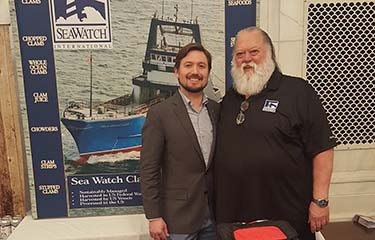PFAS are quickly becoming a big problem for the seafood industry

In July 2022, the seafood industry got its first taste of what increasing consumer and regulatory attention on per- and polyfluoroalkyl substances (PFAS) chemicals could deliver after the U.S. Food and Drug Administration found detectable levels of the chemicals in 3.75-ounce cans of Bumble Bee Smoked Clams.
As a result of the testing, Bumble Bee and then Crown Prince were forced to issue recalls. That caught the attention of Sea Watch International Senior Vice President of Sales and Marketing Guy Simmons.
“That brought the PFAS issue to the forefront for me. Then I did a lot of reading. I come from a QA background so I wanted to know all about the issue. Those clams were imported, shallow-water clans that are caught in basically tidal waters. So you get all the runoff all the fertilizers, all the sewage, in those areas in Asia,” he told SeafoodSource. “We're in federal waters and we're fishing up to 250 feet deep up to 180 miles offshore. So the chances of pollution [in Sea Watch products] is much slimmer, which is something I always tell my customers about when they’re concerned about environmental issues.”
But Simmons said he’s increasingly certain the PFAS issue is going to become a major issue for the seafood industry.
“Our customers are telling us, ‘You’ve got to tell us that you have none of this in your products.’ It's rapidly becoming an issue for the supply chain to provide assurances [on PFAS]. They're asking us, we're asking them. It goes up the chain,” he said. “I had a meeting last week with [our quality assurance department] and purchasing and I told them, ‘We’ve got to do something. You got to write letters just like everybody is writing letters to us and get assurances of what it’s not in, and then we're going to have to create some kind of document to go back to our customers, just saying our breading supplier assures us that by 2025, they will no longer be using these things.’”
Fish from Alaska to Maine have been found to contain high levels of PFAS, though mostly fish caught recreationally in fresh-water lakes and rivers. The FDA’s first survey of PFAS in processed foods, completed in 2021, found levels of the chemicals in certain seafood items, but the agency said it was not concerned about the discovery.
In February 2023, the U.S. Environmental Protection Agency set stricter limits on PFAS contamination in drinking water, and dozens U.S. states are now considering legislation cracking down on PFAS, following Maine, which became the first state to ban the use of the chemicals in new products – though not until 2030. Seven state legislatures are currently drafting bills related to PFAS lawsuits that would increase liability for manufacturers and extend the statute of limitations, or hold companies responsible for the medical monitoring costs of residents in polluted communities, according to The Pew Charitable Trusts.
But the problem won’t be easy to solve – eliminating PFAS from drinking water sources alone will cost about USD 400 billion (EUR 370 billion), Politico reported in 2022. And bans or limits on PFAS won’t impact products manufactured abroad.
Eurofins Food Chemistry Testing Contaminants Manager Grace Bandong oversees the Eurofins lab in Madison, Wisconsin, U.S.A. where PFAS testing is conducted. She told SeafoodSource PFAS are a collection of thousands of chemicals, some of which have been found to cause thyroid problems, infertility, and several types of cancer in humans and animals, and are “generally present everywhere.”
“But the concern in seafood happens to come from water contaminated by PFAs. Also from dairy products from livestock exposed to PFAS,” she said. “The EPA continues to do research as everybody else are continuing to do research, and the studies they've already done show that most of the population has been exposed to PFAS one way or another.”
Currently, the chemicals of biggest concern to the seafood industry are PFOA, or perfluorooctanoic acid, and PFOS, or perfluoro-octane sulfonate. But just a small fraction of the thousands of PFAS have been tested for toxicity, and all PFAS are either extremely persistent in the environment or break down into long-lasting PFAS, according to Bandong.
“[PFOA and PFOS] are [just] the most widely used and the two we have the most information on,” she said.
Seafood caught or grown next to water bodies close to manufacturing plants that are known to have used PFAS have a greater chance of testing positive for high levels of PFAS.
“If I ran a seafood company, I would be really strongly monitoring [for PFAS], and adding regulation measures to regular safety programs and then monitoring your environment, and where you’re sourcing from,” Bandong said. “[PFAS] are there. I would say having a good understanding of where your product stands relative to the PFAs issue is the one singular step I think that's important to take. Understanding your sources and how you’re maintaining control [is critical].”
PFAS can also be found in secondary ingredients used in value-added production, as well as in packaging material – including metal cans and plastic wrapping, according to a study published 28 March in Environmental Science and Technology Letters.
Due to the known exposure risks of using smaller PFAS molecules like PFOA and PFOS in food-contact materials, many companies have pivoted to ...
Photo courtesy of Science Center for Marine Fisheries





Share